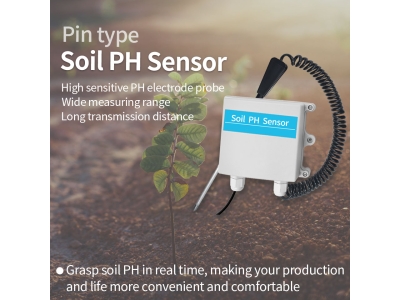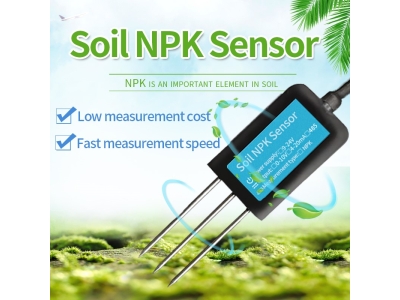Introduction: Agriculture plays a crucial role in providing food for the growing global population. However, traditional farming methods often face challenges such as variable soil conditions, changing weather patterns, and limited access to resources. These challenges can lead to inefficient use of water, fertilizers, and energy, resulting in reduced agricultural productivity and increased environmental impact. To address these issues, soil sensor technology has emerged as a promising solution. This article explores the significance of soil sensor technology in improving agricultural productivity and discusses its benefits and applications.

Significance of Soil Sensor Technology: Soil sensors are devices that measure various soil parameters, including moisture content, temperature, nutrient levels, and pH. These sensors provide real-time data on soil conditions, enabling farmers to make informed decisions about irrigation, fertilization, and other agronomic practices. By accurately monitoring soil conditions, farmers can optimize resource use, improve crop yield and quality, and minimize environmental impact. Soil sensor technology offers several advantages over traditional farming methods, making it a valuable tool for modern agriculture.
Benefits of Soil Sensor Technology:
Efficient Water Management: Water scarcity is a significant concern in agriculture, particularly in regions with limited water resources. Soil sensors provide real-time data on soil moisture levels, helping farmers determine the optimal irrigation schedule. By avoiding under or over-watering, farmers can conserve water, reduce costs, and improve water use efficiency.
Precise Nutrient Management: Nutrient availability in the soil is critical for plant growth and productivity. Soil sensors measure nutrient levels, allowing farmers to adjust fertilizer application rates based on actual plant requirements. This precision in nutrient management helps minimize fertilizer waste, reduce environmental pollution, and promote sustainable agriculture.
Enhanced Crop Health and Quality: Soil sensors can detect early signs of crop stress, such as water or nutrient deficiencies. This enables farmers to take timely corrective measures, preventing yield losses and maintaining crop health. Additionally, by optimizing soil conditions, soil sensor technology can enhance crop quality, resulting in higher market value and customer satisfaction.
Applications of Soil Sensor Technology:
Irrigation Management: Soil sensors play a vital role in irrigation management by providing real-time data on soil moisture levels. This information helps farmers adjust irrigation schedules, ensuring that crops receive the right amount of water at the right time. By optimizing irrigation, farmers can prevent water stress, minimize water wastage, and improve crop productivity.
Nutrient Management: Soil sensors enable precise nutrient management by monitoring nutrient levels in the soil. This data helps farmers determine the appropriate fertilizer type, timing, and application rate. By supplying crops with the right nutrients at the right time, farmers can maximize yield, minimize nutrient runoff, and reduce fertilizer expenses.
Climate Adaptation: Climate change poses significant challenges to agriculture, with changing weather patterns and extreme events affecting crop growth and productivity. Soil sensor technology can help farmers adapt to these changes by providing real-time data on soil conditions. This information allows farmers to adjust their agricultural practices, such as irrigation and fertilization, to mitigate the impact of climate variability.
Conclusion: Soil sensor technology offers tremendous potential for enhancing agricultural productivity and sustainability. By providing real-time data on soil moisture, nutrient levels, and other parameters, soil sensors enable farmers to make data-driven decisions and optimize resource use. Improved water and nutrient management, enhanced crop health and quality, and better climate adaptation are just some of the benefits of soil sensor technology. As agricultural technology continues to advance, soil sensor systems are expected to become more sophisticated, enabling farmers to maximize their crop production while minimizing environmental impact.
Optimizing Nutrient Management with Smart Soil Sensor Systems
Introduction: Nutrient management is a critical aspect of modern agriculture, as it directly impacts crop yield, quality, and environmental sustainability. Traditionally, farmers have relied on manual soil sampling and laboratory analysis to determine nutrient levels in the soil. However, this approach is time-consuming, costly, and often provides delayed results. To overcome these challenges, smart soil sensor systems have emerged as a promising solution. This article explores the significance of optimizing nutrient management and discusses how smart soil sensor systems can revolutionize this aspect of agriculture.
Significance of Optimizing Nutrient Management: Nutrients are essential for plant growth and development. However, excessive or imbalanced nutrient application can lead to nutrient runoff, water pollution, and diminished crop performance. On the other hand, inadequate nutrient supply can result in nutrient deficiencies and reduced yields. Optimizing nutrient management is crucial to ensure that crops receive the right nutrients in the right quantities at the right time. By adopting precision nutrient management practices, farmers can maximize crop productivity, reduce fertilizer waste, and minimize their environmental impact.
Benefits of Smart Soil Sensor Systems in Nutrient Management:
Real-time Monitoring: Smart soil sensor systems provide real-time data on nutrient levels in the soil. This allows farmers to make timely decisions regarding fertilizer application, ensuring that crops receive the required nutrients throughout their growth stages. Real-time monitoring also enables farmers to respond promptly to changes in nutrient availability, preventing nutrient deficiencies or excesses.
Precision Application: Smart soil sensor systems enable precision nutrient management by providing accurate and detailed information about nutrient levels in the soil. Farmers can analyze this data and adjust fertilizer application rates and timing accordingly. Precision application ensures that crops receive the optimal amount of nutrients, maximizing their growth potential and minimizing fertilizer waste.
Cost Reduction: By adopting smart soil sensor systems, farmers can reduce their fertilizer expenses. These systems provide accurate and up-to-date information on nutrient status in the soil, allowing farmers to determine the exact amount of fertilizer needed. This prevents excess fertilizer application, which not only saves costs but also reduces the risk of nutrient runoff and environmental pollution.
Applications of Smart Soil Sensor Systems in Nutrient Management:
Nutrient Monitoring: Smart soil sensor systems continuously monitor nutrient levels in the soil, providing farmers with real-time data on nutrient content. This information helps farmers understand the nutrient requirements of their crops and make informed decisions regarding fertilizer application rates and types. By adopting precision nutrient management, farmers can optimize nutrient utilization and enhance crop productivity.
Variable Rate Application: Smart soil sensor systems can be integrated into precision agriculture practices, allowing for variable rate fertilizer application. By mapping nutrient levels across a field, farmers can apply fertilizers at different rates in different areas. This ensures that each crop receives the precise amount of nutrients required, based on the specific conditions of that area. Variable rate application maximizes nutrient use efficiency and reduces environmental impact.
Nutrient Budgeting: Smart soil sensor systems assist farmers in developing nutrient budgets based on accurate soil nutrient data. By analyzing nutrient levels and crop nutrient requirements, farmers can plan their fertilizer application in a more precise and efficient manner. Nutrient budgeting helps farmers optimize nutrient management, reduce fertilizer costs, and minimize the risk of nutrient runoff.
Conclusion: Optimizing nutrient management is vital for sustainable and productive agriculture. Smart soil sensor systems provide farmers with real-time data on soil nutrient levels, enabling them to make informed decisions regarding fertilizer application. By adopting precision nutrient management practices, farmers can maximize crop yield, improve nutrient use efficiency, and minimize environmental impact. Smart soil sensor systems offer tremendous potential for revolutionizing nutrient management in agriculture, contributing to more sustainable and efficient farming practices. As technology continues to advance, these systems are expected to become even more sophisticated, providing farmers with more precise and comprehensive information for optimizing nutrient management.






